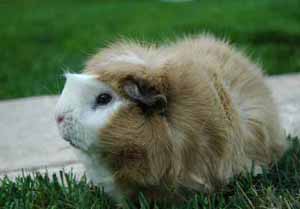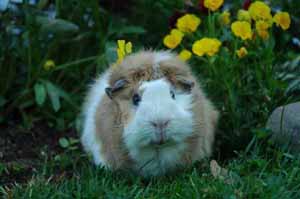Guinea Pig - Cavia porcellus
Guinea pigs come from South America in the Andes Mountains. They are called "cavys" and have been used as food for the inhabitants of South America. In the US, guinea pigs have been used as research animals. It is not a good idea to house two males since fights may break out. If you have other pets such as dogs or cats, it has been written that you could "introduce" friendships - it is a rare dog that will tolerate a guinea pig (I have a black lab that let the guinea pig touch noses and walk around' however always done with supervision). Cats - I don't let the cat near when the guinea pig is out. Both cats and dogs are predators and guinea pigs are prey. If you have cats and dogs and want a guinea pig, do yourself a favor separate them and keep it that way.
They are great animals that do not need a lot of care - but they do need care. They are social and since you probably do not own a herd you must be the substitute herd. Your guinea pig needs attention and care. I would rate guinea pigs as intermediate pets. More work than hermit crabs but not quite as much as a dog.
Average Size - Guinea pigs can grow to 2 to 3 lbs. and average 10 to 14 inches in length. 
Life Span - Typical life span of an average guinea pig is between 5 and 7 years. It is possible that they may live somewhat longer. The guinea pig pictured to the right is 5 years old.
Diet - Guinea pigs are herbivorous - therefore no meats, cheese etc. It is essential for you to provide your guinea pig with enough vitamin C. A piece of an orange or other fruit and vegetables such as kale and strawberries high in vitamin C will meet the recommended requirements. Guinea pig pellets are formulated to supply the necessary vitamin C. Be careful, rabbit pellets do not have the requisite formulations and will not provide the essential nutrients and vitamins. For more information about guinea pig diet and foods - Guinea Pig diet and foods
Feeding - We leave the hay in the hay rack all day. Pelleted food is given the morning - we leave any spilled food in the cage for the day. Treats (veggies, fruits etc.) are given once a day and removed after 1 - 2 hours.
Housing - You need to have a location that is free from drafts and wind. Prolonged exposure can put undue stress on your guinea pig and leave it prone to disease. With that being said, you do need to provide a cage/hutch for your pet that is ventilated. Ammonia from urine and dust from bedding can cause respiratory distress serious enough to kill your pet. Avoid a cage with a screen (large holes) floor that covers the entire cage area since it can cause pain and foot problems for your cavy. A cage that has an area of smooth shelving for flooring is a good resting spot. I do not like aquarium tanks - there is not enough ventilation and humidity can build up. A good wire mesh cage that is sturdy enough to keep your pet in and trouble out is all that is needed. The cage should be big enough for your guinea pig to stretch out, move around and stand up in - keep in mind that they can grow up to 14 inches.
Substrate - Pine shavings work fine.
Temperature - Temperatures above 85 degrees F can put undue stress on your pet. Guinea pigs cannot handle high temperatures and humidity. If you live in an area where summertime temperatures can exceed this - especially if accompanied by high humidity, try and find your pet a cool, dry place.
Lighting - Guinea pigs evolved to live in burrows and in the wild tend to be nocturnal. There are no special lighting requirements for your cavy other than the cage should not be in direct sunlight. It can cause your guinea pig to overheat - which could kill it. You should provide enough light - indirect is fine - to allow your guinea pig to develop a day-night routine.
Water - Clean water must always be available to your guinea pig. Don't use a water in a dish, your guinea pig will knock it over causing wet bedding that has the potential to grow mold/fungus and other problems. Use a  commercial brand sipper bottle with an aluminum tube, since guinea pigs nibble the end. One problem I have encountered is that we have never found a water bottle that does not leak. It is very important to change the water daily, and clean the bottle each week. To clean you can use a weak bleach/water solution of 1 part bleach to 10 parts water. If you find mold inside the bottle make sure you clean thoroughly. We own two bottles one is clean and ready to be used as we clean the one currently in use. commercial brand sipper bottle with an aluminum tube, since guinea pigs nibble the end. One problem I have encountered is that we have never found a water bottle that does not leak. It is very important to change the water daily, and clean the bottle each week. To clean you can use a weak bleach/water solution of 1 part bleach to 10 parts water. If you find mold inside the bottle make sure you clean thoroughly. We own two bottles one is clean and ready to be used as we clean the one currently in use.
Normal Behavior and Interaction - Guinea pigs are social animals in the wild, however; as pets they are usually confined to cages etc. Territory fights between males can and will happen. Each guinea pig has a personality of its own and particular individuals can be aggressive. Remember that guinea pigs are prey animals which means that they are timid around new situations.
When becoming aggressive, your cavy may stiffen its legs and raise up. When this happens, stay away!!
Guinea pigs are vocal animals and make various noises:
Squealing - our cavy squeals when we are near and it wants attention or near feeding time.
Teeth clattering - this means stay away. Pushing a cavy as it is clicking its teeth may eventually lead to a bite.
Cooing and gurgling - you are doing all right and your pet is happy.
Find out what the first years cost of owning a guinea pig in our articles section of PET EDU
Habitat with secure lid - avoid a cage with a screen (large holes) floor that covers the entire cage area since it can cause pain and foot problems for your cavy.
Recommended Supplies:
- Water bottle - do yourself a favor buy 2
- Book about guinea pigs
- Toys
- Substrate - pine shavings or newspapers
|
- Hide box - guinea pigs like to feel secure
- Hay rack you can attach to your cage
- chew toys - important their teeth grow
- food dish
|
Habitat Maintenance - Change water daily. Thoroughly clean the cage at least once week - depending on your guinea pig; scrub the cage and furnishings with a weak bleach/water solution; rinse thoroughly with water, removing all smell of bleach; dry the cage and furnishings; and add clean substrate
Grooming and Hygiene - Guinea pig's teeth grow throughout their life. They need to have chew toys available or else they will end up with dental problems and poor health. You will need to clip their toenails periodically. Learn to do this or else go to your vet. Comb your guinea pig on a regular basis - and while at it keep an eye out for anything that does not look normal.
Signs of a Healthy Pet:
- Clean and healthy looking fur
- clear clean eyes
- regular bowl movements
|
- active
- clean nose
- vocal sounds such as cooing
|
Common Health Issues and Red Flags:
- Bald spots or patches on your cavy's fur
- Dull look in the eyes
- lethargy
- loss of appetite
- Constipation or diarrhea
|
- Discharge in the eyes or nose
- bloated abdomen
- labored breathing
- sudden weight loss
|
Typically, I would list health related issues guinea pigs are susceptible to, however; the following website has a rather extensive checklist: cavymadness.com
If you notice any of these signs, please contact your exotic animal veterinarian.
As with all pets in this category, it is important that you find a veterinarian that practices in EXOTICS – this is critical. The typical small animal practitioner may not have sufficient knowledge in this area. Even this guide is general in nature and should not be used to diagnose your pet.
|



 commercial brand sipper bottle with an aluminum tube, since guinea pigs nibble the end. One problem I have encountered is that we have never found a water bottle that does not leak. It is very important to change the water daily, and clean the bottle each week. To clean you can use a weak bleach/water solution of 1 part bleach to 10 parts water. If you find mold inside the bottle make sure you clean thoroughly. We own two bottles one is clean and ready to be used as we clean the one currently in use.
commercial brand sipper bottle with an aluminum tube, since guinea pigs nibble the end. One problem I have encountered is that we have never found a water bottle that does not leak. It is very important to change the water daily, and clean the bottle each week. To clean you can use a weak bleach/water solution of 1 part bleach to 10 parts water. If you find mold inside the bottle make sure you clean thoroughly. We own two bottles one is clean and ready to be used as we clean the one currently in use.